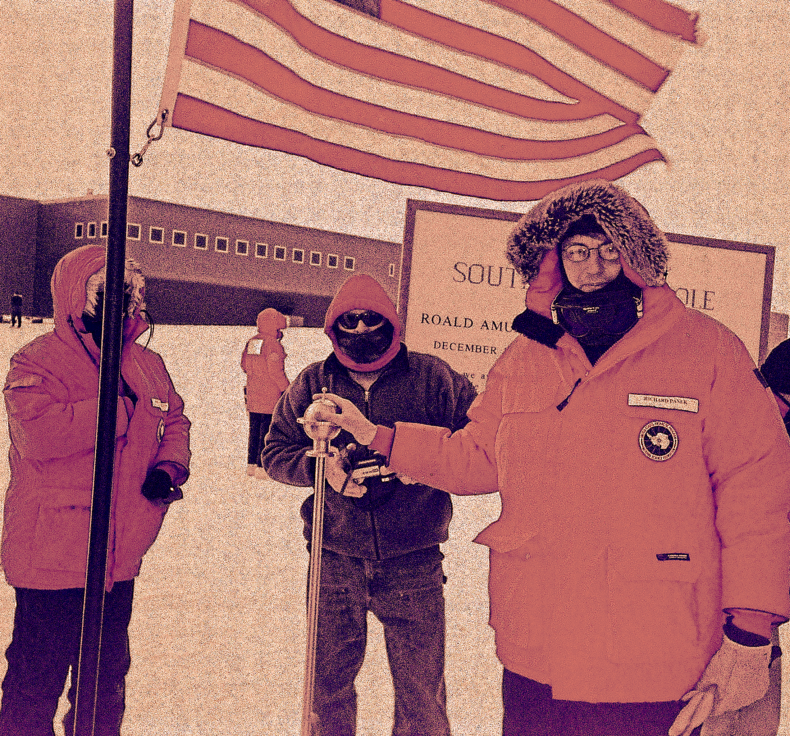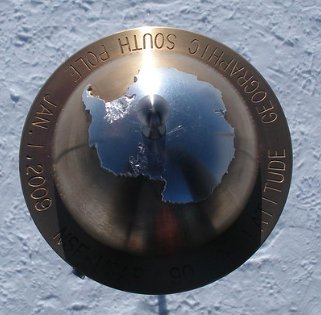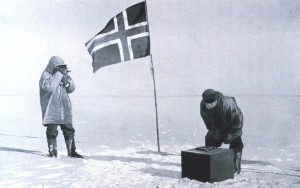
By the time you read this post, 2020 will have already arrived at the South Pole. Even if you read it the instant it pops up on the Internet, at 7 a.m. EST December 31, 2019, the New Year will already be an hour old.
You don’t have to go to the South Pole to appreciate how arbitrary our conceptions of space and time are, but it helps. And eleven years ago today (tomorrow? yesterday?) I found myself, thanks to a grant from the National Science Foundation to support research for a book, at the Pole.
By “at the Pole,” I don’t just mean at the Amundsen-Scott South Pole Station, the modern and rather posh living quarters for the approximately 200 scientists and support personnel who work there during the October-to-February austral summer, as well as the 50 or so who keep the place running for the rest of the year.
Nor do I mean the various outposts within walking distance where scientists conduct research in astronomy, geology, particle physics, climatology, and other areas.
And I don’t mean the ceremonial South Pole, the striped-barbershop photo-op version, semi-encircled by the flags of the twelve nations that signed the 1961 treaty setting aside the continent for scientific pursuits.
I mean at the Pole.

The Amundsen-Scott station perches 9,300 feet above sea level, of which the first 9,000 feet down are ice. That ice sheet drifts about 10 meters each year, taking with it the station, the research outposts, and a pole—a metal shaft that sticks out of the ice. Unlike the ceremonial pole several dozen yards away, this pole designates the geographic South Pole—one end of the axis around which the Earth rotates. Every New Year’s Day the pole is relocated from the point where the Pole was a year earlier to the point where the GPS says the Pole is now.
The New Year’s Day I was there, however, the tradition came with a new addition. “Line up,” someone from the National Science Foundation told the score or more of us who had ventured from the station to witness the ceremony. We lined up, starting at the pole. Someone lifted the pole and passed it to the next person in line. That person passed it to the next, and then that person passed it to the next, and so on. As the pole made its way down the line to my right, I turned to my left, to see to whom I would soon be passing the pole. Nobody was there. I was at the end of the line. Instead of the boots of one more Polie, I found myself looking at a hole in the snow. This hole, I realized with a start, was the Pole.
Dare I step on it? Then I would really, truly be at the South Pole. But stepping on a hole that someone had pre-drilled seemed sacrilegious, or at least risky; what if snow spilled into the hole and I ruined the whole ceremony? Then again, not stepping on it seemed like missing the chance of a lifetime. In a moment, a pole was going to be in that hole, and nobody would be able to stand at the Pole—really, truly—for another year. Or stand at the Pole knowingly, anyway, since the ice sheet would be drifting, and you might well be standing next to the pole yet standing at the Pole. But right now, at this precise moment, the Pole was naked. And accurate.
A glance to my right. The pole was maybe a dozen people away. They were passing, passing, passing.
A glance to my left. The hole was half a foot away. My boot was threatening to take on a life of its own. My toes were clenching and unclenching, straining against the hard and blunt boot tip. My arch was arching, then relaxing. In the end, though, the boot didn’t budge.
Instead, I did. I leaned over. Looked down. Peered into the hole, or down the two or three inches that were visible. If I could see farther, if I could keep seeing down, if my vision could drill through the Earth, then I would eventually reach the North Pole, the other end of the axis around which the planet rotates. I thought about how cosmologists often answer the question of what came before the Big Bang: It’s like asking what’s north of the North Pole. Or, similarly, what’s south of the South Pole.
From here, this precise point, the world went nothing but north, like a universe expanding. What did it expand into?—another common question about the Big Bang. The answer: The universe didn’t expand into anything. It became space. It became time. The more space that it became, the more time that passed.
I straightened and turned back. The pole had arrived. I accepted it from the Polie to my right, and then an NSF official stepped up to me and held out his gloves. I handed him the pole. At several minutes past 1 p.m., he planted it.
But wait. How does this space where there’s nothing but north—where time zones originate, fattening with the longitudes all the way to the Equator, then thinning again until they converge at the point where there’s nothing but south—get this time? Why is the moment of the planting of the pole at 1 p.m. January 1 rather than, say, 7 p.m. December 31? Why is the South Pole Station, along with a healthy swath of Antarctica, on New Zealand Time, which is the first time zone west of the International Date Line?
Because the treaty said so.
By the way, the International Telecommunications Union added a leap second at midnight that year. But let’s not go there.
* * *
Image credits: Unknown (top); Nick Powell, courtesy of the National Science Foundation (middle); “Taking an observation at the pole,” The South Pole, by Roald Amundsen, Volume II (bottom).

That is so cool. I’m a rule follower; I probably wouldn’t have stepped there, either. But oh, the temptation!